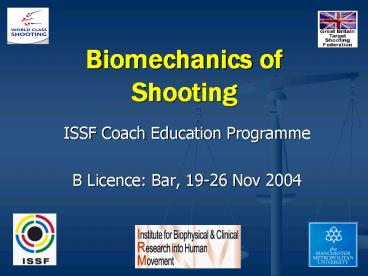Biomechanics of Shooting - PowerPoint PPT Presentation
1 / 16
Title:
Biomechanics of Shooting
Description:
Analysis of the way in which the body moves and the forces responsible for ... Camera stationary on a tripod. No panning of tilting. High shutter speed selected ... – PowerPoint PPT presentation
Number of Views:645
Avg rating:3.0/5.0
Title: Biomechanics of Shooting
1
Biomechanics of Shooting
- ISSF Coach Education Programme
- B Licence Bar, 19-26 Nov 2004
2
Biomechanics
- The science that examines the mechanical basis
for human movement. - Analysis of the way in which the body moves and
the forces responsible for that movement. - Kinematics movement
- Kinetics forces
3
Biomechanics in sport
- Biomechanics has been used to examine
- Optimal performance characteristics
- Technique change training / competition
- Influence of equipment on performance
- Relative injury risk of different tasks
- Video / High speed film
- Force platform
- EMG
4
Biomechanics of shooting
- Movement characteristics of different disciplines
- Identify key performance factors
- Comparison of different levels of performance
- Postural sway characteristics
- force platform
- Centre of Pressure
- SCATT / NOPTEL
5
Technique analysis with video
- Why use video
- Permanent record of performance
- Addressed some of the human limitations to
observation - Allows you to concentrate on other factors during
training and competition - Permits objective analysis
- Enhances feedback
6
Requirements for video analysis
- Clear field of view
- Camera location to ensure desired variables can
be identified - Camera stationary on a tripod
- No panning of tilting
- High shutter speed selected
- Maximize image size
7
Measurements from video
- Video works at 25 frames per second and therefore
1 picture is produced every 0.04 s. - Timing data can thus be gained by counting frames
between key events. - Angles can be measured only if the camera is
located perpendicular to joint of interest.
8
Temporal characteristics of skeet
9
Computer based kinematic analysis
- The video image is played back through a computer
and for each frame the locations (coordinates) of
key joint centres and body landmarks are
recorded. - This process is known as digitising.
- Allows movement time plots to be created
- Many coaching tools available
- Dartfish
- Quintic
- Silicon-coach
10
Joint angle time in skeet
11
Force platforms and shooting
- Postural stability / sway
- Amount of sway
- Timing of sway
- Rate of sway
- Often in combination with opto-electronic data
e.g. SCATT / NOPTEL - Weight distribution
- Left / right
- Forward / backwards
12
COP Time in Skeet
13
(No Transcript)
14
Individual Characteristics
- Essential not to rely on group analyses when
working with elite athletes. - INTRA-shooter comparisons should be used as each
shooter has a clear biomechanical finger-print. - Relationship between sway and shot success has
yet to be proven as a discriminating factor
with-in elite shooters. - Measurable v Important characteristics
15
Factors influencing sway
- Base of support
- Height of centre of mass
- Fatigue
- Cardiac output ?
- There is a measurable force (but small) change as
a consequence of the acceleration of blood
through the aorta, may influence motion of CoP.
No evidence at this affects stability of targeting
16
Biomechanics in coaching
- Evaluation of training and competition
performance. - Identification of key performance
characteristics. - Quantification of practice effects.
- Supporting and enhancing feedback.
- Understanding demands of technique and
relationship to common injuries.































